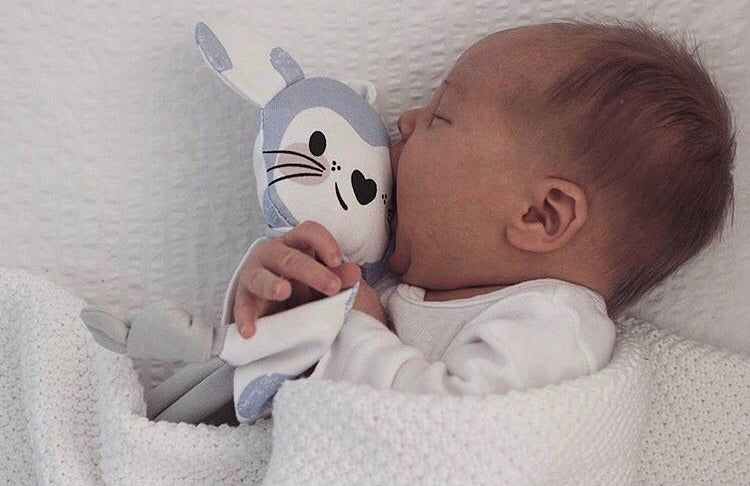How do Kippins Cuddle Blankies promote better sleep for baby?

What is this magical Kippin thing? How does it ‘put’ your baby to sleep? Is it filled with some sort of magic sleep dust? You’ll find the answers to all things “blankie” or baby comforter below!
Why do I need a baby comforter?
For a baby, life is full of change and transitions. Their brain is constantly developing and they are always learning new skills. There’s so much change, in fact, that they can go to sleep one day and wake up the next to a whole new world!
Around six months of age, developmental changes lead to baby feeling separation anxiety for the first time. We wrote a great article on this here.

This transitional state can be unsettling, causing stress and anxiety when baby realises that you can up and leave whenever you like, and that they are a person separate from their Mum or Dad.
So how does a baby ‘attach’ to an object and how does a baby comforter work?
Attachment is a psychological phenomenon, whereby a baby transfers the natural feelings of attachment they have for caregivers to an inanimate object. This is a result of repeated and consistent introduction to this object as part of a pattern of behavior. In simple terms, including this object at every nap is a sign to the baby that this is an item of comfort and that it is time for sleep.
If your child is attached to a baby comforter, when they wake throughout the night they will soothe themselves back to sleep using the comforter, without needing assistance from you.
What is a baby comforter?
A transitional object is something permanent that can help baby during times of change, and during the transition from a state of dependence to independence such as:
Being looked after by family and friends (hello Tuesdays at Grandma and Gramps!)
- Starting daycare
- Learning to sleep on their own
- Doctors or hospital visits (like immunisations)
These are most often in the form of small blanket like object (research has shown that babies under 18 months of age prefer something with blanket-like properties). They’re also safer – read this article here). It provides a sense of calm and security – a reminder that it’s ALL GOOD! Most parents will find that their child chooses their own transitional object that meets the baby’s need for love and affection when their caregivers aren’t around (or that they can control when under stress). It could be something random like your sleeve and it gets a little tricky if your baby attaches to an object that can’t stick around (like you, you need sleep after all!), or be replaced. Research has shown that attachment to a comforter is indicative of a strong parent-child bond, as the baby shares their feelings of love for their parents to their first special friend.
A baby comforter can literally be anything – for example, a square of muslin cloth with some knots tied in it. There are a bunch of new comforters on the market which claim to magically put baby to sleep (some even include electronics and batteries, simulating heartbeats and white noise). People often find that these magically work in the beginning to get baby to fall asleep, but that baby will also look for the sound or noise every time they wake during the night. If baby does not know how to fall asleep on their own, nothing will help magically keep them asleep.
For babies who have not yet learnt to link their sleep cycles (i.e. fall asleep by themselves when they naturally wake every 30-50 mins), this can mean going in to turn on the noise/sound every single time the baby wakes. These objects also only work if the child becomes attached to the object (the toy) itself and learns how to self settle. We believe white noise can be helpful to put babies to sleep (especially if your house is noisy, hello older siblings), but find that it is easier to buy a separate white noise machine or use an app.
The same is true for a dummy. If baby uses their dummy to go to sleep, they will look for the dummy to help themselves fall back asleep every time they wake. Lots of Kippins parents use dummies, and tie up to four on each leg so that baby can easily find their dummy themselves in the night. Dummies and Kippins are very complimentary, and when you decide it’s time to say goodbye to the dummy a Kippin can help!

A note about sleep associations.
You’ll here people talk about ‘positive and negative sleep associations’. Our opinion is that a sleep association (i.e. something your baby/child identifies as a sign it’s time for bed or uses to fall asleep) is only negative if it impacts your sleep or your child’s sleep, and if you want to change it. Examples of sleep associations include:
- A baby comforter like a Kippin (or any baby comforter you choose)
- Dummy
- Rocking, patting or swinging to sleep
- Signing and lullabies
- Wrapping and swaddling or using a sleeping bag
Why are our baby comforters the best?
In creating Kippins, we wanted to add a storytelling component to a very simple object, just to see the pure joy on babe’s face when they see the character they love on the pages of a book they read every night before bed. Our comforters are also:
- 100% organic including the stuffing and safe for your baby to chew and suck (spoiler: they will!)
- Our fabric is smooth, lightweight and breathable. There are no fluffy bits that can be inhaled or ingested and no embroidery or buttons that can come loose.
- Machine washable
- Affordable
Read our article on how to introduce a comforter here!
Or shop our range of baby comforters online now. There are ten Kippiny characters to choose from.


